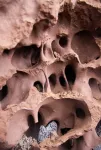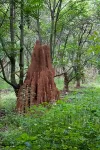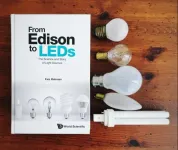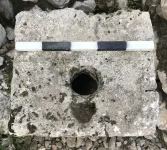(Press-News.org) Among the approximately 2,000 known species of termites, some are ecosystem engineers. The mounds built by some genera, for example Amitermes, Macrotermes, Nasutitermes, and Odontotermes, reach up to eight meters high, making them some of the world’s largest biological structures. Natural selection has been at work improving the ‘design’ of their mounds over tens of millions of years. What might human architects and engineers learn if they go to the termites and consider their ways?
In a new study in Frontiers in Materials, researchers showed how termite mounds can teach us to create comfortable interior climates for our buildings that don’t have the carbon footprint of air conditioning.
“Here we show that the ‘egress complex’, an intricate network of interconnected tunnels found in termite mounds, can be used to promote flows of air, heat, and moisture in novel ways in human architecture,” said Dr David Andréen, a senior lecturer at the bioDigital Matter research group of Lund University, and the study’s first author.
Termites from Namibia
Andréen and co-author Dr Rupert Soar, an associate professor at the School of Architecture, Design and the Built Environment at Nottingham Trent University, studied mounds of Macrotermes michaelseni termites from Namibia. Colonies of this species can consist of more than a million individuals. At the heart of the mounds lie the symbiotic fungus gardens, farmed by the termites for food.
The researchers focused on the egress complex: a dense, lattice-like network of tunnels, between 3mm and 5mm wide, which connects wider conduits inside with the exterior. During the rainy season (November through April) when the mound is growing, this extends over its north-facing surface, directly exposed to the midday sun. Outside this season, termite workers keep the egress tunnels blocked. The complex is thought to allow evaporation of excess moisture, while maintaining adequate ventilation. But how does it work?
Andréen and Soar explored how the layout of the egress complex enables oscillating or pulse-like flows. They based their experiments on the scanned and 3D-printed copy of an egress complex fragment collected in February 2005 from the wild. This fragment was 4cm thick with a volume of 1.4 liters, 16% of which were tunnels.
They simulated wind with a speaker that drove oscillations of a CO2-air mixture through the fragment, while tracking the mass transfer with a sensor. They found that air flow was greatest at oscillation frequencies between 30Hz and 40 Hz; moderate at frequencies between 10Hz and 20 Hz; and least at frequencies between 50Hz and 120 Hz.
Turbulence helps ventilation
The researchers concluded that tunnels in the complex interact with wind blowing on the mound in ways that enhance mass transfer of air for ventilation. Wind oscillations at certain frequencies generate turbulence inside, whose effect is to carry respiratory gases and excess moisture away from the mound’s heart.
“When ventilating a building, you want to preserve the delicate balance of temperature and humidity created inside, without impeding the movement of stale air outwards and fresh air inwards. Most HVAC systems struggle with this. Here we have a structured interface that allows the exchange of respiratory gasses, simply driven by differences in concentration between one side and the other. Conditions inside are thus maintained,” explained Soar.
The authors then simulated the egress complex with a series of 2D models, which increased in complexity from straight tunnels to a lattice. They used an electromotor to drive an oscillating body of water (made visible with a dye) through the tunnels, and filmed the mass flow. They found, to their surprise, that the motor needed to move air back and forth only a few millimeters (corresponding to weak wind oscillations) for the ebb and flow to penetrate the entire complex. Importantly, the necessary turbulence only arose if the layout was sufficiently lattice-like.
Living and breathing buildings
The authors conclude that the egress complex can enable wind-powered ventilation of termite mounds at weak winds.
“We imagine that building walls in the future, made with emerging technologies like powder bed printers, will contain networks similar to the egress complex. These will make it possible to move air around, through embedded sensors and actuators that require only tiny amounts of energy,” said Andréen.
Soar concluded: “Construction-scale 3D printing will only be possible when we can design structures as complex as in nature. The egress complex is an example of a complicated structure that could solve multiple problems simultaneously: keeping comfort inside our homes, while regulating the flow of respiratory gasses and moisture through the building envelope.”
“We are on the brink of the transition towards nature-like construction: for the first time, it may be possible to design a true living, breathing building.”
END
Termite mounds reveal secret to creating ‘living and breathing’ buildings that use less energy
Properties of ‘egress complex’ of termite mounds can be copied to optimize interior climate of buildings
2023-05-26
ELSE PRESS RELEASES FROM THIS DATE:
How eating natto might help to distress
2023-05-26
Health is wealth as the saying goes and new research now shows that it is possible to have a healthy, less stressed society through familiar and inexpensive foods. One such food might be the Japanese natto which is made from softened soybeans that have been boiled or steamed and fermented with a bacteria called Bacillus subtilis var. natto. Bacillus subtilis var. natto is found in soil, plants, animals, and the human stomach and intestines. Most of the natto consumed in Japan is made from the Miyagino strain.
A research group led by Professor Eriko Kage-Nakadai at the Graduate School of Human Life ...
A celebration of artificial light sources
2023-05-26
Did you know that until the early twentieth century, artificial light sources only served the purpose of illuminating our surroundings? Since then, significant changes have taken place. Light is now utilized in various ways beyond just space illumination. From semiconductor chip manufacturing to high-speed data communications, the increasing number of applications has led to the development of different kinds of light-producing devices. Some light sources even generate light through radioactive decays!
If you have wondered how we managed to progress from a simple lightbulb to energy-efficient LEDs, put your doubts to rest now. Delve into From Edison to LEDs: The Science and ...
Plants remove cancer causing toxins from air
2023-05-26
A ground-breaking study has revealed that plants can efficiently remove toxic gasoline fumes, including cancer causing compounds such as benzene, from indoor air.
The study was led by University of Technology Sydney (UTS) bioremediation researcher Associate Professor Fraser Torpy, in partnership with leading Australian plantscaping solutions company Ambius.
The researchers found that the Ambius small green wall, containing a mix of indoor plants, was highly effective at removing harmful, cancer-causing pollutants, with 97 per cent of the most toxic compounds removed from the surrounding air in just eight hours.
Poor indoor air quality is responsible ...
Rotman School professor honored for contributions to the field of strategic management
2023-05-26
Toronto – Anita M. McGahan, a professor at the University of Toronto’s Rotman School of Management, is this year’s recipient of the William D. Guth Distinguished Service Award from the Strategic Management Division of the Academy of Management, the preeminent professional association for management and organization scholars. In announcing the award, Division-Chair Elect Louise Mors, a professor at Copenhagen Business School, wrote that Prof. McGahan “has been dedicated to all aspects of the field of strategy” and cited ...
Women with breast cancer shed pounds thanks to telephone-based weight loss program, clinical trial finds
2023-05-26
Boston – Women with obesity when they are diagnosed with early breast cancer have a higher risk of recurrence or a second cancer compared to women whose weight is in the normal range and it can be hard to lose weight after being diagnosed with breast cancer. Now, a clinical trial has shown that a telephone-based weight loss program can help patients with breast cancer whose body mass index is in the overweight or obese range lower their weight by a meaningful degree.
The findings, to be reported by Dana-Farber Cancer Institute investigators at the American Society of Clinical Oncology (ASCO) Annual Meeting, set the ...
Why high school kids are saying no to alcohol
2023-05-26
Striking differences in the way high school students socialise may be one of the reasons behind a dramatic drop in youth drinking over the last 20 years, a study from the University of Otago, New Zealand, has found.
Public health researcher Dr Jude Ball has compared attitudes to drinking among high school students in 1999-2001 to those in 2022.
Dr Ball and colleagues Dr Michaela Pettie and Loleseti Poasa interviewed 64 students aged between 14 and 17 at a co-ed school in Wellington in 2022, and compared their views to 41 Christchurch ...
Study finds that eight factors put Black adults at greater risk of early death
2023-05-26
Black adults who live in the United States have a 59% higher risk of premature death than White adults.
A new study from Tulane University published in Lancet Public Health has found that this gap can be entirely explained by disparities in eight areas of life critical to health and well-being: employment, income, food security, education level, access to healthcare, quality health insurance, home ownership and marital status.
These eight factors are called social determinants of health. Using data from the National Health and Nutrition ...
Early toilets reveal dysentery in Old Testament Jerusalem
2023-05-26
A new analysis of ancient faeces taken from two Jerusalem latrines dating back to the biblical Kingdom of Judah has uncovered traces of a single-celled microorganism Giardia duodenalis – a common cause of debilitating diarrhoea in humans.
A research team led by the University of Cambridge say it is the oldest example we have of this diarrhoea-causing parasite infecting humans anywhere on the planet. The study is published in the journal Parasitology.
“The fact that these parasites were present in sediment from two Iron Age Jerusalem cesspits suggests that dysentery was endemic in the Kingdom of Judah,” ...
Are Emergency Departments unsafe? Patients and professionals think so
2023-05-26
Emergency departments (EDs) are currently unsafe places for both professionals and patients, according to the results of an international survey carried out for the European Society of Emergency Medicine (EUSEM) and published today (26th May) in the European Journal of Emergency Medicine1. The main reasons for this are staff shortages and overcrowding due to the non-availability of beds in wards necessitating the provision of care in corridors. Respondents to the survey also felt that they had insufficient support from hospital management.
Around 90% of professionals surveyed felt that at times the number of patients ...
New study explores how exposure to mix of toxic metals impacts developing kidneys
2023-05-25
Chronic kidney disease is a growing problem worldwide and in the aging U.S. population. But could the groundwork for this progressive disease have been laid while its victims were still in utero?
Newly launched research at the University of Pittsburgh School of Public Health seeks to determine if pregnant mothers’ environmental exposure to toxic metals impacts kidney development in their babies, setting the stage for a problem that doesn’t become apparent until the baby is an adult.
The National Institutes of Health recently awarded a three-year, $2.2 million “high risk, high reward” grant to Dr. Alison ...
LAST 30 PRESS RELEASES:
Scientists trace microplastics in fertilizer from fields to the beach
The Lancet Obstetrics, Gynecology, & Women’s Health: Taking paracetamol during pregnancy does not increase risk of autism, ADHD or intellectual disabilities, confirms new gold-standard evidence review
Taking paracetamol during pregnancy does not increase risk of autism, ADHD or intellectual disabilities
Harm reduction vending machines in New York State expand access to overdose treatment and drug test strips, UB studies confirm
University of Phoenix releases white paper on Credit for Prior Learning as a catalyst for internal mobility and retention
Canada losing track of salmon health as climate and industrial threats mount
Molecular sieve-confined Pt-FeOx catalysts achieve highly efficient reversible hydrogen cycle of methylcyclohexane-toluene
Investment in farm productivity tools key to reducing greenhouse gas
New review highlights electrochemical pathways to recover uranium from wastewater and seawater
Hidden pollutants in shale gas development raise environmental concerns, new review finds
Discarded cigarette butts transformed into high performance energy storage materials
Researchers highlight role of alternative RNA splicing in schizophrenia
NTU Singapore scientists find new way to disarm antibiotic-resistant bacteria and restore healing in chronic wounds
Research suggests nationwide racial bias in media reporting on gun violence
Revealing the cell’s nanocourier at work
Health impacts of nursing home staffing
Public views about opioid overdose and people with opioid use disorder
Age-related changes in sperm DNA may play a role in autism risk
Ambitious model fails to explain near-death experiences, experts say
Multifaceted effects of inward foreign direct investment on new venture creation
Exploring mutations that spontaneously switch on a key brain cell receptor
Two-step genome editing enables the creation of full-length humanized mouse models
Pusan National University researchers develop light-activated tissue adhesive patch for rapid, watertight neurosurgical sealing
Study finds so-called super agers tend to have at least two key genetic advantages
Brain stimulation device cleared for ADHD in the US is overall safe but ineffective
Scientists discover natural ‘brake’ that could stop harmful inflammation
Tougher solid electrolyte advances long-sought lithium metal batteries
Experts provide policy roadmap to reduce dementia risk
New 3D imaging system could address limitations of MRI, CT and ultrasound
First-in-human drug trial lowers high blood fats
[Press-News.org] Termite mounds reveal secret to creating ‘living and breathing’ buildings that use less energyProperties of ‘egress complex’ of termite mounds can be copied to optimize interior climate of buildings









